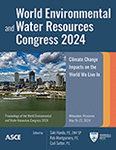Reference Evapotranspiration Comparison of Any Two Cities Using Python and NASA Power’s API
Publication: World Environmental and Water Resources Congress 2024
ABSTRACT
This study delves into the science and practical application of estimating reference evapotranspiration (ETo) with a specific focus on city environments. Urbanization’s growing footprint has significant implications for water resource management and environmental engineering, making accurate ETo assessments crucial for informed decision-making. The present research presents a code developed to facilitate the comparison of ETo dynamics between two cities, spanning from 1990 to the present day. Leveraging NASA’s powerful climate datasets through their APIs, this code addresses key data management challenges, ensuring the reliability and quality of the analysis. Importantly, the code employs the Penman-Monteith equation, renowned for its accuracy, to enhance precision in ETo estimation. The code provides an intuitive interface, empowering researchers and practitioners to explore and contrast ETo patterns between cities of their choice within specified date ranges. The implementation relies on a selection of Python libraries, including Geocoder, NumPy, and Matplotlib, to facilitate seamless data processing, visualization, and interpretation. Validation exercises were conducted against field data collected in Haryana, India, establishing the code’s robustness and its potential as a powerful tool for climate data analysis. This research significantly advances city climate studies, enabling a deep understanding of ETo variations between diverse city settings. This study promotes data-driven decision-making and sustainable practices for a resilient future.
Get full access to this chapter
View all available purchase options and get full access to this chapter.
REFERENCES
Alexandris, S., Kerkides, P., and Liakatas, A. (2006). Daily reference evapotranspiration estimates by the “Copais” approach. Agricultural water management, 82(3), 371–386.
Allen, R. G., Pereira, L. S., Raes, D., and Smith, M. (1998). Crop evapotranspiration-Guidelines for computing crop water requirements-FAO Irrigation and drainage paper 56. Fao, Rome, 300(9), D05109.
Allen, R. G., Walter, I. A., Elliott, R., Howell, R., Itenfisu, D., and Jensen, M. (2005). RL Snyder, The ASCE Standardized Reference Evapotranspiration Equation. Environmental and Water Resources Institute of the American Society of Civil: Reston, FL, USA.
DehghaniSanij, H., Yamamoto, T., and Rasiah, V. (2004). Assessment of evapotranspiration estimation models for use in semi-arid environments. Agricultural water management, 64(2), 91–106.
Feng, Y., Cui, N., Zhao, L., Hu, X., and Gong, D. (2016). Comparison of ELM, GANN, WNN and empirical models for estimating reference evapotranspiration in humid region of Southwest China. Journal of Hydrology, 536, 376–383.
Ghamarnia, H., Mousabeyg, F., Amiri, S., and Amirkhani, D. (2015). Evaluation of a few evapotranspiration models using lysimetric measurements in a semi-arid climate region. International Journal of Plant & Soil Science, 5(2), 100–109.
Kelly, T. D., and Foster, T. (2021). AquaCrop-OSPy: Bridging the gap between research and practice in crop-water modeling. Agricultural Water Management, 254, 106976.
Kelly, T. D., Foster, T., and Schultz, D. M. (2023). Assessing the value of adapting irrigation strategies within the season. Agricultural Water Management, 275, 107986.
Kisi, O. (2016). Modeling reference evapotranspiration using three different heuristic regression approaches. Agricultural Water Management, 169, 162–172.
Lee, Y. R., Yoo, J. M., Jeong, M. J., Won, Y. I., Hearty, T., and Shin, D. B. (2013). Comparison between MODIS and AIRS/AMSU satellite-derived surface skin temperatures. Atmospheric Measurement Techniques, 6(2), 445–455.
Monteiro, L. A., Sentelhas, P. C., and Pedra, G. U. (2018). Assessment of NASA/POWER satellite‐based weather system for Brazilian conditions and its impact on sugarcane yield simulation. International Journal of Climatology, 38(3), 1571–1581.
Najmaddin, P. M., Whelan, M. J., and Balzter, H. (2017). Estimating Daily Reference Evapotranspiration in a Semi-Arid Region Using Remote Sensing Data. Remote Sensing, 9(8):779.
Najmaddin, P. M. (2017). Simulating river runoff and terrestrial water storage variability in data-scarce semi-arid catchments using remote sensing (Doctoral dissertation, University of Leicester).
Quansah, A. D., Dogbey, F., Asilevi, P. J., Boakye, P., Darkwah, L., Oduro-Kwarteng, S., and Mensah, P. (2022). Assessment of solar radiation resource from the NASA-POWER reanalysis products for tropical climates in Ghana towards clean energy application. Scientific Reports, 12(1), 10684.
Rojas, J. P., and Sheffield, R. E. (2013). Evaluation of daily reference evapotranspiration methods as compared with the ASCE-EWRI Penman-Monteith equation using limited weather data in Northeast Louisiana. Journal of Irrigation and Drainage Engineering, 139(4), 285–292.
Tasumi, M., Trezza, R., Allen, R. G., and Wright, J. L. (2005). Operational aspects of satellite-based energy balance models for irrigated crops in the semi-arid US. Irrigation and Drainage Systems, 19, 355–376.
Tayyeh, H. K., and Mohammed, R. (2023). Analysis of NASA POWER reanalysis products to predict temperature and precipitation in Euphrates River basin. Journal of Hydrology, 619, 129327.
Thorp, K. R. (2022). pyfao56: FAO-56 evapotranspiration in Python. SoftwareX, 19, 101208.
Tomlinson, J. E., Arnott, J. H., and Harou, J. J. (2020). A water resource simulator in Python. Environmental Modelling & Software, 126, 104635.
Widmoser, P. (2009). A discussion on and alternative to the Penman–Monteith equation. Agricultural Water Management, 96(4), 711–721.
Zhang, L., Zhao, X., Zhu, G., He, J., Chen, J., Chen, Z., and Singh, V. P. (2023). Short-term daily reference evapotranspiration forecasting using temperature-based deep learning models in different climate zones in China. Agricultural Water Management, 289, 108498.
Zotarelli, L., Dukes, M. D., Romero, C. C., Migliaccio, K. W., and Morgan, K. T. (2010). Step by step calculation of the Penman-Monteith Evapotranspiration (FAO-56 Method). Institute of Food and Agricultural Sciences. University of Florida, 8.
Information & Authors
Information
Published In
History
Published online: May 16, 2024
ASCE Technical Topics:
- Analysis (by type)
- Climates
- Comparative studies
- Computer languages
- Computer programming
- Computing in civil engineering
- Construction engineering
- Construction management
- Data analysis
- Engineering fundamentals
- Environmental engineering
- Evaporation
- Evapotranspiration
- Hydrologic engineering
- Infrastructure
- Methodology (by type)
- Research methods (by type)
- Standards and codes
- Urban and regional development
- Urban areas
- Water and water resources
Authors
Metrics & Citations
Metrics
Citations
Download citation
If you have the appropriate software installed, you can download article citation data to the citation manager of your choice. Simply select your manager software from the list below and click Download.
